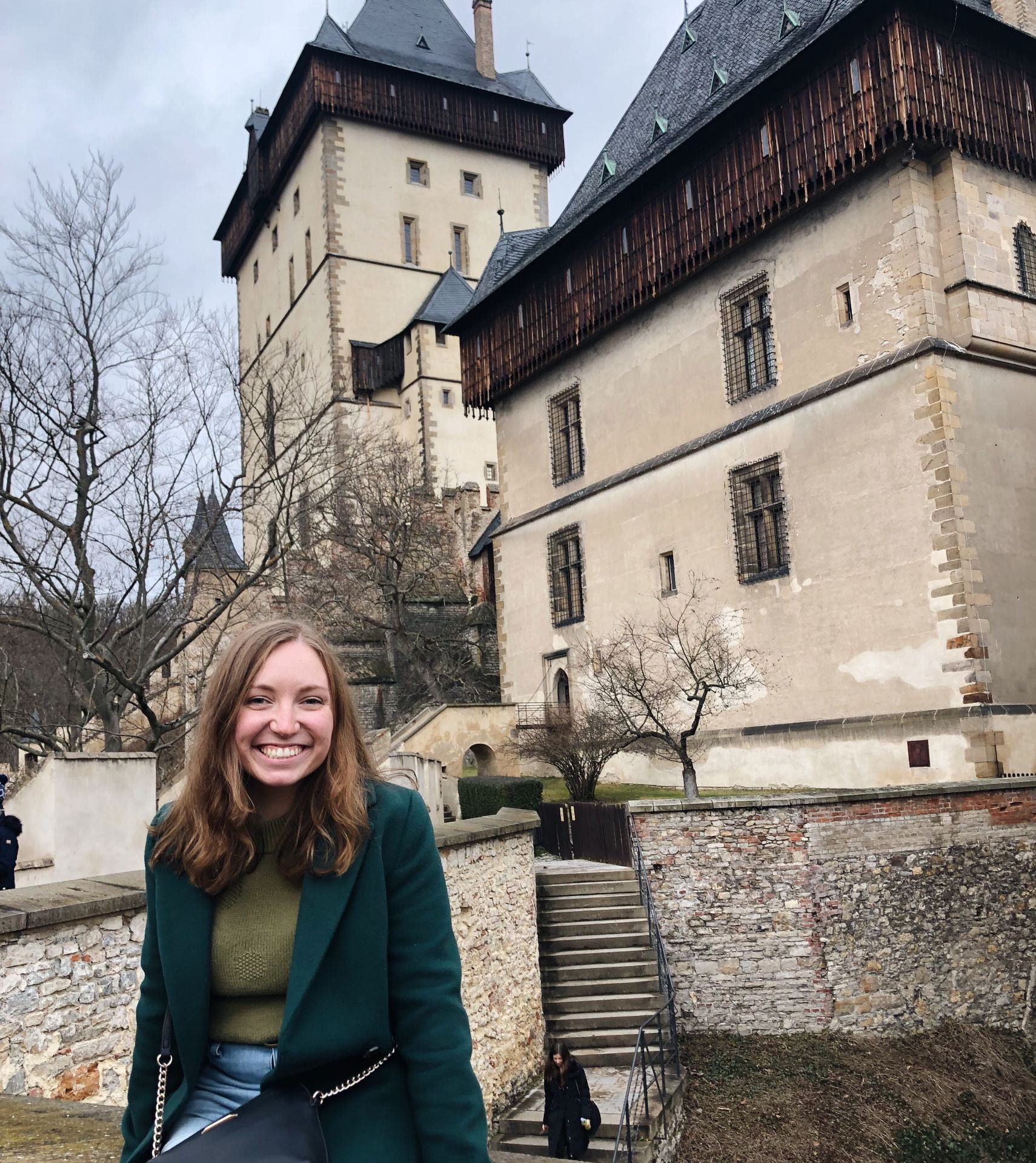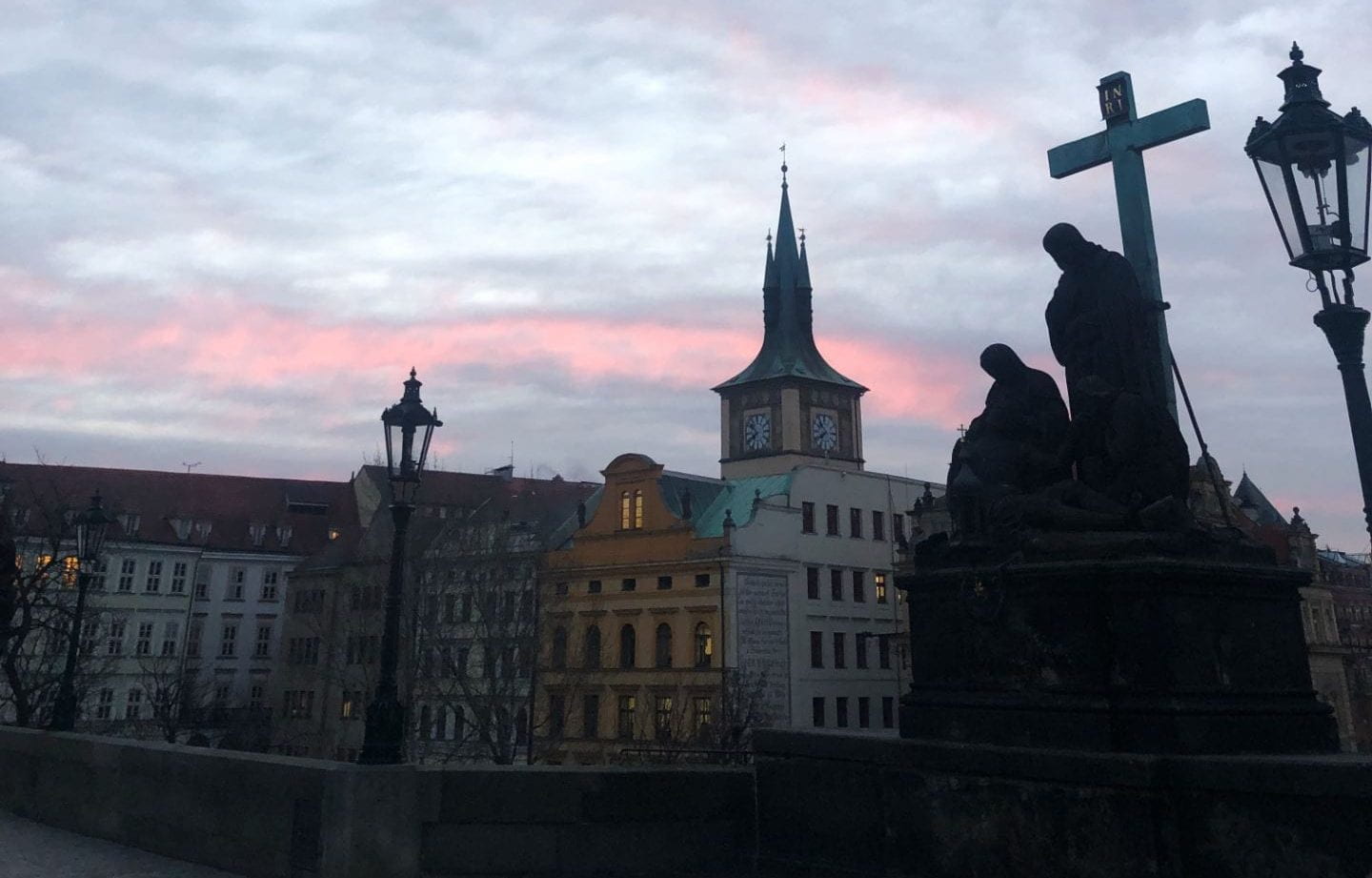 Katie Strickland, an honors student studying international relations, political science and history, spent the 2022 January intercession studying abroad in Prague as part of the CIEE program in social psychology. While abroad, Katie became fascinated with the equally visible and invisible history of the rapidly changing city where she studied.
Katie Strickland, an honors student studying international relations, political science and history, spent the 2022 January intercession studying abroad in Prague as part of the CIEE program in social psychology. While abroad, Katie became fascinated with the equally visible and invisible history of the rapidly changing city where she studied.
It was a Thursday in mid-January, and my hands were frozen. My breath billowed into vapor clouds as the below-freezing temperatures made my feet hop even more swiftly from cobblestone to cobblestone. The sky was dark overhead as the sun remained hidden from the world; our student group’s early wake-up call of 6:45 am had made sure of that. After a quick ride through the city’s metro system, we emerged right in the center of Prague’s Old Town, ready to make our way to the famous Charles Bridge and watch the sun eventually rise and turn the sky all shades of pink, purple, and blue.
Upon making it to the bridge over the Vltava River, we were surprised to find such an iconic part of the city empty. Only morning runners and commuters of all ages dared to cross the bridge at such an hour. We hurried to take our pictures and explore the bridge as we waited in the dark. Then came the silence, as we waited patiently in the frigid dark for the sun to arrive, almost afraid to disturb the peace and compete with the slow, sure noise of the river flowing. I embraced it all, taking in the solid stone underneath my feet, the towers standing above me, and the buildings and trees lining the hills and streets laid out before me. These features had been here centuries before me and would continue for many after me as well. In one glance, I could see layers upon layers of history, each built within its context and each with its memory attached. All were rooted within one shared place.
The sun finally began to rise, staining colors across the sky like watercolors. The city itself was coming to life, stretching its limbs and yawning as it too pushed against the cold. From my perch on the bridge, I could spot the tram lines moving along the river, more and more people boarding their vintage cars. The street’s lamplights flicked off, and the noises of the city gradually began to compound. Even within the last few decades, to say much had changed within the Czech Republic would be an understatement. From the social to the political, the Prague of 2021 was widely different from that three decades prior; despite the changes though, the city itself still bore many the signs of change and deeply etched memories of various pasts. Prague was a city that remembered, and its history was borne both by what I could see from my early-morning vantage point and what I could not see that was harbored internally by the Czech people.
My academic program in Prague, facilitated by the external organization CIEE, emphasized to us the importance of this shared memory to the Czech people. As a part of our Social Psychology course, several of our assignments centered around examinations of Czech culture and how it was distinct from our own, whether that entail norms in personal space, social cues, ideas of etiquette among friends and strangers, and especially the nuances of a built social identity. In a guest lecture surveying the concept of effective leadership and support-building, the idea of utilizing collective memory to define a shared group identity was intensively explored. When people could relate their personal experiences to one another and build community around such connections, the bonds they built assumed an even greater emotional and social strength. The content of the memories themselves did not have to be identical; the power of the emotions they elicited was crucial, especially when empathized with among the group. When combined with shared ties to a specific place, such as Prague, a group defined by its common social identity was created.
This memory-shaped identity was on full display throughout our time in the Czech Republic. Even our initial walking tour throughout Old and New Towns evidenced this. Beginning in Wenceslas Square, our tour guide Eva tied nearly every space we visited back to personal memories of hers. The statue of St. Wenceslas that stands in the shadow of the Národní Muzeum had witnessed some of the most significant demonstrations during the Prague Spring and the Velvet Revolution, periods of resistance against the communist regime. To Eva, this place was also where she and her friends had gathered in the post-soviet 1990s after communist rules outlawing large gatherings had been voided. Further down the square was a seemingly normal balcony on a business building not situated in any significant way along the row of facades. Yet, to Eva and countless other Czechs who had gathered in Wenceslas Square in November 1989, this balcony was where she had first heard Václav Havel, the future first president of a non-communist Czech Republic, speak in person to the Czech people about the principles of freedom and democracy.
Pieces of old and new continued to intertwine throughout the three weeks we spent in Prague. Twice, we peered across the city at night from the roof of the National Theatre, waiting for the opera to begin again within its 140-year-old gilded and carpeted home. Just thirty years prior, the streets below us hosted hordes of students during the Velvet Revolution, and, as they met police violence, their parents inside the theater stopped production to defend their children. Also overlooking these events were the large windows of the Café Louvre, which we visited following the opera on New Year’s Day. The pink-patterned walls surrounding us as we downed our hot chocolates and lattés were the same that had hosted such scientific and cultural leaders as Albert Einstein and Franz Kafka, whose literary works had set the foundation for the Czechoslovak political and intellectual movements of the 1960s. Layers of history quite literally surrounded us, and the personal ties and memories which bound the Czech people to a collective sense of place within Prague reinforced the importance of these layers all the more.
 With each passing day in Prague, our group began to carve memories out within the city. From the Charles Bridge where we watched the sunrise, we could spot the passing railroad cars which had carried us the weekend prior to Karlštejn, the fourteenth-century fortress of Holy Roman Emperor Charles IV. Prague is known to many as the City of Hundred Spires, including the Astronomical Tower of the Klementinum, home to historical achievements in astronomy and gorgeous panoramic views of the city that we enjoyed on a clear, blue-skies day. Turning the other way on the bridge towards Lesser Town, otherwise known as Malá Strana, one can see the John Lennon Wall peeking through the trees with its brightly painted words and designs overlapping one another and evidencing years of Czechs and visitors to Prague alike leaving messages for the world to see. Each part of the city held meaning to someone, and our coursework in social psychology thankfully challenged us to recognize and cherish these pieces and their potency as much as possible.
With each passing day in Prague, our group began to carve memories out within the city. From the Charles Bridge where we watched the sunrise, we could spot the passing railroad cars which had carried us the weekend prior to Karlštejn, the fourteenth-century fortress of Holy Roman Emperor Charles IV. Prague is known to many as the City of Hundred Spires, including the Astronomical Tower of the Klementinum, home to historical achievements in astronomy and gorgeous panoramic views of the city that we enjoyed on a clear, blue-skies day. Turning the other way on the bridge towards Lesser Town, otherwise known as Malá Strana, one can see the John Lennon Wall peeking through the trees with its brightly painted words and designs overlapping one another and evidencing years of Czechs and visitors to Prague alike leaving messages for the world to see. Each part of the city held meaning to someone, and our coursework in social psychology thankfully challenged us to recognize and cherish these pieces and their potency as much as possible.
To those who are fortunate enough to visit Prague or any part of the Czech Republic in the future, I would strongly encourage paying attention to memory throughout your travels, just as such attention was encouraged for me by my instructors and coordinators at CIEE. On its face, Prague is a beautiful city. From the pastel-colored rows of buildings and cobblestone streets, to the glittering Vltava and stunning cityscapes (of which there are many – if there is a tower in Prague, there is a 75% chance you can climb it), the city easily distinguishes itself superficially. However, the true beauty of the city came to me through the deeply-rooted memories and emotions which are sewn into the fabric of the city by those residents who have lived through decades of the city’s history. Take the time to learn about the many layers of history behind the streets you walk through. If you have the opportunity, listen to the stories of the Czech people whose sense of belonging in Prague is strong because they fought for the freer Czech Republic of today. Enjoy the svíčková and smažený sýr, try to learn some of the Czech language, and even revel in the relative silence of the public transportation (it is an unspoken rule to remain respectfully quiet on metros and trams).
Through my experiences in the Czech Republic, I was able to make my own memories all across the city, from freezing on the Charles Bridge at sunrise to even celebrating my 22nd birthday in a small Czech restaurant at the base of Karlštejn. By building my knowledge of Czech history and my connections with the Czech people I interacted with through my academic program, I was able to contextualize my place-bound experiences within a much broader collective memory. This deep emotional meaning and national pride which ties the people of the Czech Republic so tightly back to Prague continues to amaze me and leaves me even more excited to further learn about intersections between place and national memory in my future academic and international endeavors.
